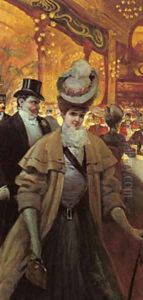Milliere Maurice Paintings
Maurice Millière was a French artist, known for his paintings, illustrations, and engravings. Born on October 28, 1816, in Le Havre, France, he would go on to develop a style characterized by its elegance, often depicting scenes of daily life with a particular focus on feminine beauty and charm. Millière's work captured the essence of the Belle Époque era in France, a period of peace and prosperity that allowed for the flourishing of the arts.
Millière initially trained at the École des Beaux-Arts in Paris, where he honed his artistic skills. He was influenced by the Realist movement, which was prominent at the time, as well as by the works of the Impressionists, who were beginning to challenge the traditional approaches to painting. Throughout his career, Millière exhibited at the Paris Salon, the official art exhibition of the Académie des Beaux-Arts in Paris, where he gained recognition and accolades for his work.
In addition to his paintings, Millière was also a successful illustrator and engraver. He contributed to various French periodicals and illustrated books, where his depictions of women, often in playful and slightly suggestive poses, were particularly popular. His illustrations often featured modern Parisian women, capturing their fashion and leisure activities, thus documenting the changing roles and images of women during the late 19th century.
Maurice Millière's artistry extended beyond the canvas and printed page; he was also known for his work in the decorative arts, designing furniture and home decorations which echoed the Art Nouveau style that was becoming popular at the turn of the century. His attention to detail and his ability to capture the nuances of light and shadow made his works highly sought after by the burgeoning middle class of the time.
Millière's career spanned much of the 19th century, a dynamic period in French art. Despite the social and political upheavals of the time, including the events of the 1848 Revolution and the Franco-Prussian War of 1870-71, he managed to maintain a successful career as an artist. Maurice Millière passed away on December 18, 1899, leaving behind a body of work that continues to be appreciated for its historical value and aesthetic charm.
